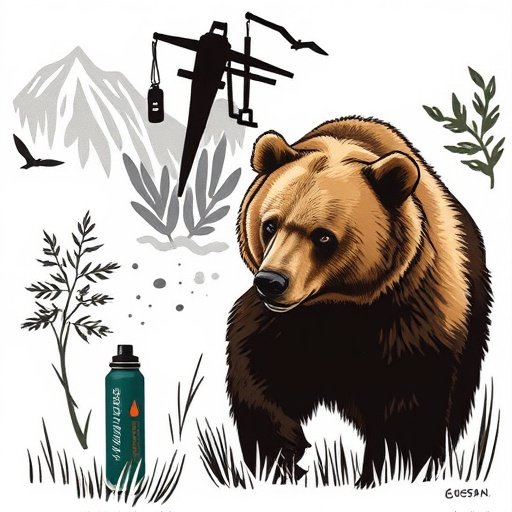Bear spray residue acts as a protective barrier in wildlife encounters, using capsaicin to temporarily disorient bears and encourage retreat. While non-toxic, it can have significant ecological impacts on local ecosystems and animal populations if misused or improperly disposed of. Responsible usage, storage, and disposal techniques are vital to minimize these impacts while enhancing personal safety during encounters with wildlife, especially in areas like Alaska's wilderness.
“Camping enthusiasts and outdoor adventurers, ensure your safety in Alaska’s wild with Guard Alaska spray. This comprehensive guide explores bear spray residue, its impact on wildlife and ecosystems, and critical handling practices. Understand how this powerful tool works against aggressive bears while minimizing environmental harm. Discover safe storage methods and effective use strategies for maximum protection during your next Alaskan adventure. By following these steps, you’ll navigate the wilderness with confidence and peace of mind.”
- Understanding Bear Spray Residue: How It Works
- Wildlife Impact: Protecting Animals and Ecosystems
- Safe Handling and Storage: Minimizing Environmental Risk
- Effective Use Strategies: Ensuring Personal Safety in the Wild
Understanding Bear Spray Residue: How It Works
Bear spray residue is designed to create a barrier between you and potential wildlife encounters, specifically bears. When activated, the spray releases a fine mist containing capsaicin, the same compound found in chili peppers. This irritates the bear’s eyes, nose, and respiratory system, temporarily disorienting it and encouraging it to retreat.
Understanding how bear spray residue works is crucial when considering its impact on wildlife. Unlike other deterrents that might harm animals directly, bear spray residue has minimal long-term effects on bears and other wildlife. The capsaicin is non-toxic and quickly metabolized by the body. However, it’s essential to remember that bear spray should only be used as a last resort during dangerous encounters, ensuring responsible usage for maximum effectiveness and minimal environmental impact.
Wildlife Impact: Protecting Animals and Ecosystems
When camping in areas where wildlife is present, it’s crucial to understand how your actions and gear can impact them. Bear spray, like Guard Alaska’s offerings, is a vital tool for personal safety against aggressive bears. However, it’s not just about protecting yourself; bear spray residue can have significant effects on local ecosystems and animal populations.
The active ingredients in bear spray can persist in the environment, potentially harming non-target species that come into contact with it. This includes birds, small mammals, and other wildlife that might mistake the residue for food or become trapped in affected areas. Proper usage and disposal techniques are essential to minimize these impacts. Always follow instructions carefully, avoid spraying unnecessarily, and properly dispose of used cans to help preserve the delicate balance of nature around you.
Safe Handling and Storage: Minimizing Environmental Risk
Proper handling and storage of bear spray is crucial to minimizing both personal risk and environmental impact. Always keep bear spray in its original packaging, with the nozzle intact, to prevent accidental discharge. Store it out of reach of children and pets, and away from heat sources or direct sunlight, as extreme temperatures can affect its performance. When transporting bear spray, ensure it’s securely fastened to avoid damage or accidental release of the spray, which could harm wildlife or contaminate water sources with bear spray residue.
Remember, responsible storage practices help ensure the safety of both yourself and the ecosystem you’re exploring. By keeping bear spray in check, you reduce the risk of unintentional wildlife impact, preserving the balance of nature as you enjoy your outdoor adventure.
Effective Use Strategies: Ensuring Personal Safety in the Wild
When venturing into Alaska’s wild, ensuring personal safety against unexpected wildlife encounters is paramount. One effective tool in your survival kit is bear spray, like Guard Alaska spray. To maximize its effectiveness, understand proper usage strategies. Aim for the face and eyes of approaching bears, creating a barrier of bear spray residue. This can deter or temporarily incapacitate the animal, providing crucial time to escape.
Avoid spraying lightly or from a distance; the goal is to create a dense cloud of spray that blankets the bear. Practice using your spray regularly to become familiar with the trigger and spray pattern. Keep in mind that bear spray is not a guarantee against attacks but can significantly improve your chances of avoiding and escaping dangerous situations, ensuring your safety amidst Alaska’s breathtaking yet unpredictable wilderness.
Camping safely in Alaska requires understanding how bear spray residue interacts with wildlife and the environment. By knowing the impact of bear spray, proper handling and storage techniques, and effective use strategies, outdoor enthusiasts can ensure their personal safety while minimizing harm to wildlife and ecosystems. Always remember that responsible usage of bear spray is key to a safe and enjoyable camping experience in Alaska’s wild landscapes.
